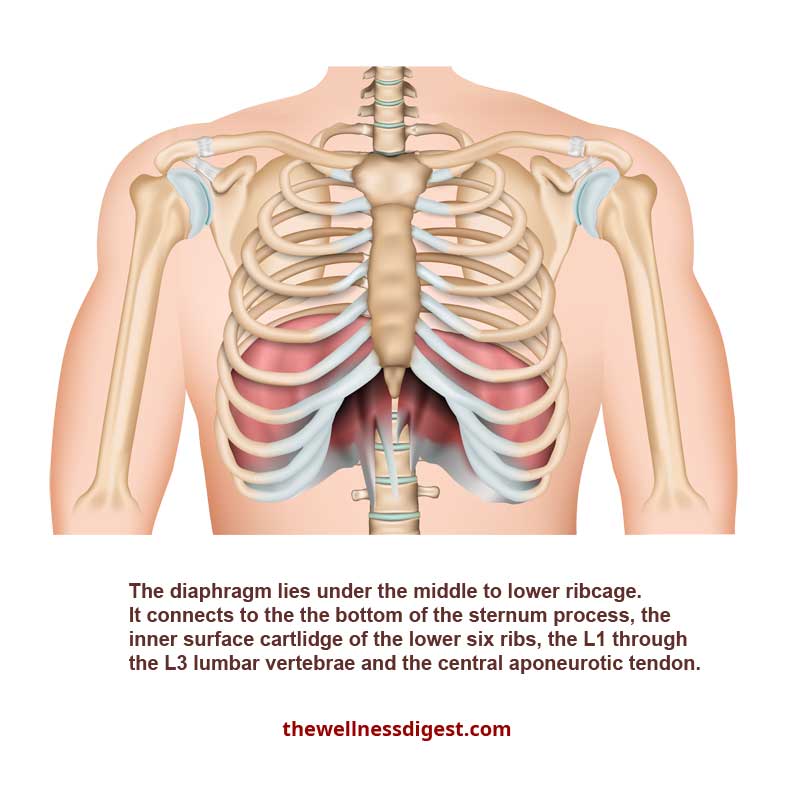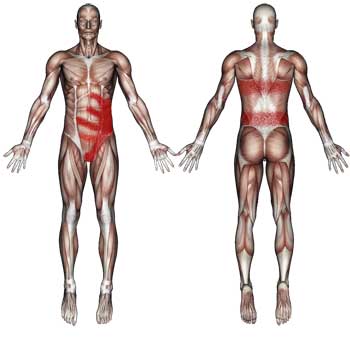The diaphragm is the primary breathing muscle. It is a thin, dome-shaped muscle located under the ribs, laying between the vital organs of the chest and the abdominals. Trigger points in the muscle cause pain around the bottom of the rib cage and a band of pain across the middle of the back.
Where Is The Diaphragm Muscle?

The muscle lies under the middle to lower rib cage. It connects to the xiphoid process, the inner surface of the lower six costal cartilages, the L1 through the L3 lumbar vertebrae, and the central aponeurotic tendon.
What Movements Does It Control?
It raises and expands the ribcage when inhaling, allowing the lungs to fill with air.
Are you looking for detailed muscle anatomy? The Diaphragm Muscle Anatomy Page has origin, insertion, innervation, and blood supply information. It also lists agonists and antagonists for each muscle action.
Advertisement
Diaphragm Muscle Trigger Points Symptoms:

Trigger points in the diaphragm do not radiate or refer pain to other areas of the body. The pain concentrates around the bottom of the ribs.
Problems with the diaphragm will often cause a band of pain across the middle of the back. If you are experiencing bands of pain across the upper and middle back, check the diaphragm, even if you are not having the typical diaphragm TrP symptoms.
The symptoms:
- Pain in the lower chest
- Pain around the bottom ribs
- Discomfort inhaling
- Can cause a ‘stitch’ or sharp pain in the side
- A band of pain across the middle back
- If you have heartburn and indigestion, you will often find TrPs in the diaphragm.
What Causes Trigger Points To Develop In The Diaphragm?
If your breathing is affected, the diaphragm is affected. If you have chronic breathing conditions, regularly checking and eliminating TrPs will help ease your breathing.
Other causes:
- Labored breathing (asthma, emphysema, bronchitis, pneumonia)
- Gasping for air during sports activities
- Hyperventilation
- Coughing
- Hiccups
- Slumping posture
TWD Recommends
 If you have rounded shoulder, forward head posture, or a habit of slouching, correcting your posture will reduce muscle pain. The Truweo Posture Corrector is adjustable and comfortable. It gently pulls your shoulders back, which helps retrain muscle memory to maintain proper posture. Many people notice an immediate reduction of pain and tension. Start slowly, wearing the brace for short periods throughout the day gradually increasing the time-worn.
If you have rounded shoulder, forward head posture, or a habit of slouching, correcting your posture will reduce muscle pain. The Truweo Posture Corrector is adjustable and comfortable. It gently pulls your shoulders back, which helps retrain muscle memory to maintain proper posture. Many people notice an immediate reduction of pain and tension. Start slowly, wearing the brace for short periods throughout the day gradually increasing the time-worn.
How To Avoid Development of Trigger Points In The Diaphragm
- You must maintain proper posture. Slumping inhibits your ability to breathe correctly.
- If you are a shallow (chest) breather, it negatively affects many muscles in the neck, chest, upper back, as well as the diaphragm. Practice deep breathing, inhaling until the stomach expands, then exhale slowly. Keep practicing until it becomes a habit!
- If you have a chronic breathing condition and experience heartburn regularly, checking and treating TrPs in the muscle may bring some relief.
- If you find yourself gasping for air during exercise or other activities, stop and catch your breath.
Tip: If you have a case of hiccups, take a small sip of apple cider vinegar, it will usually stop immediately. A spoon of sugar can work but is not as effective as vinegar.
TWD Recommends
 The Cureve Hot Cold Pack can be used for warm and cold treatments. It is recommended that you use cold packs for injuries, swelling, and after a TrP treatment. Use a warm treatment when the muscle is tight and needs to relax.
The Cureve Hot Cold Pack can be used for warm and cold treatments. It is recommended that you use cold packs for injuries, swelling, and after a TrP treatment. Use a warm treatment when the muscle is tight and needs to relax.
Diaphragm Muscle Trigger Point Treatment

Eliminating trigger points in the diaphragm can help ease pain and can help improve your breathing, even if you have a chronic breathing condition.
There are massage therapists, physical therapists, and chiropractors trained in trigger point therapy to show you how to find and treat specific TrPs. Not all have the specified training so ask before making an appointment.
With the help of The Trigger Point Therapy Workbook, you can learn to treat the diaphragm along with other muscles in the body. The book includes diagrams that will help you locate TrPs and treat them. It takes a little practice to learn the feel of trigger points, but once you learn, you can treat muscles throughout the body. I recommend this book to anyone interested in learning about muscle pain.
Sombra Warming Gel can help ease discomfort by gently warming the area, helping muscles relax. Rub a small amount into the lower ribcage concentrating on the soft area at the bottom of the ribs. Sombra is also effective for the band of back pain.
How Long Before I Feel A Reduction In Pain?
Diaphragm trigger points often take several treatments to deactivate. Fortunately, most people feel some relief quickly.
I have found that the best treatment plan for trigger points in the diaphragm is one treatment in the morning and another in the evening. This area is sensitive, and applying pressure throughout the day, which is the recommendation for other trigger points, is irritating instead of healing.
For a successful outcome, be consistent with your treatments and continue treatment until the TrP is deactivated (gone).
Interesting facts:
Pain around the bottom of the ribs is often diagnosed as inflammation of the ribs, separated ribs, ulcers, or gallbladder dysfunction. These symptoms can be trigger points in the diaphragm.
Diaphragm muscle pain and symptoms can be similar to, contribute to, and be affected by these medical diagnoses:
- Fracture of lower ribs
- Costochondritis
- Shortness of breath
- Pleurisy
- Chronic Obstructive Pulmonary Disease (COPD, Emphysema)
- Pneumonia or Bronchitis
- Asthma
- Sprain/Strain or Tear of the Rectus abdominis, Internal or External Obliques, or Intercostals
- Gallbladder Disease
- Splenic Disease
- Pancreatitis
Advertisement
Other muscles that should be considered and examined:
Other muscles that should be considered and examined:
Satellite trigger points associated with the diaphragm muscles:
If you find trigger points in the diaphragm, you will likely find trigger points in the rectus abdominis.
TWD Recommends
 You’re tired. Your muscles are sore and stiff. All you want to do is lie down and be able to relax.
You’re tired. Your muscles are sore and stiff. All you want to do is lie down and be able to relax.
The Snailax Vibrating Massage Mat With Heat is made for those times. The mat features a full-body vibrating massage and has multiple settings for massage and heat. The remote allows you to adjust settings with a push of a button. An excellent way to ease aches and pains in the back, hips, and legs at the end of the day! Sixty-nine inches (5′ 9″) long.
Additional muscles that may contribute to these symptoms:
ASTHMA | BREATHING TROUBLE | CHEST PAIN | COPD | COSTOCHONDRITIS | EMPHYSEMA | GALLBLADDER DISORDERS | PANCREATITIS | PLEURISY | RIB PAIN | SIDE STITCH | SPLEEN DISORDERS | ULCER


